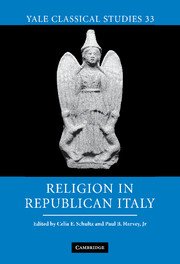Book contents
- Frontmatter
- Contents
- List of illustrations
- List of contributors
- Acknowledgments
- List of abbreviations
- Introduction
- Chapter 1 Reconsidering “religious Romanization”
- Chapter 2 In search of the Etruscan priestess: a re-examination of the hatrencu
- Chapter 3 Etruscan religion at the watershed: before and after the fourth century bce
- Chapter 4 Religious locales in the territory of Minturnae: aspects of Romanization
- Chapter 5 Religion and memory at Pisaurum
- Chapter 6 Inventing the sortilegus: lot divination and cultural identity in Italy, Rome, and the provinces
- Chapter 7 Hot, cold, or smelly: the power of sacred water in Roman religion, 400–100 bce
- Chapter 8 Religion and politics: did the Romans scruple about the placement of their temples?
- Chapter 9 Juno Sospita and Roman insecurity in the Social War
- Chapter 10 Beyond Rome and Latium: Roman religion in the age of Augustus
- Bibliography
- Index
Introduction
Published online by Cambridge University Press: 08 January 2010
- Frontmatter
- Contents
- List of illustrations
- List of contributors
- Acknowledgments
- List of abbreviations
- Introduction
- Chapter 1 Reconsidering “religious Romanization”
- Chapter 2 In search of the Etruscan priestess: a re-examination of the hatrencu
- Chapter 3 Etruscan religion at the watershed: before and after the fourth century bce
- Chapter 4 Religious locales in the territory of Minturnae: aspects of Romanization
- Chapter 5 Religion and memory at Pisaurum
- Chapter 6 Inventing the sortilegus: lot divination and cultural identity in Italy, Rome, and the provinces
- Chapter 7 Hot, cold, or smelly: the power of sacred water in Roman religion, 400–100 bce
- Chapter 8 Religion and politics: did the Romans scruple about the placement of their temples?
- Chapter 9 Juno Sospita and Roman insecurity in the Social War
- Chapter 10 Beyond Rome and Latium: Roman religion in the age of Augustus
- Bibliography
- Index
Summary
The study of Roman religion as a topic worthy of scholarly inquiry in its own right – as opposed to being considered a farrago of quaint local traditions, folklore, and stray Etruscan influences (especially ritual) unsystematically presided over by imported Hellenic anthropomorphic deities – was established on firm foundations by Mommsen's study and explication of the Roman calendar in the first volume of the first edition of the Corpus Inscriptionum Latinarum (1863). Here Mommsen reconstructed the cycle of the Roman religious year by elucidating epigraphic fragments of ancient calendars with information scattered in our surviving literary sources. Mommsen's edition was followed, in due time, by a revised presentation in the second edition of CILi (1893) and by Georg Wissowa's magisterial handbook, Religion und Kultus der Römer (1st edn., 1905; 2nd edn., 1912), still a fundamental reference work supplemented and complemented, not replaced, by K. Latte's Römische Religionsgeschichte of 1960. At the time Wissowa was preparing a second edition of his handbook, another significant study of Roman religion founded on Mommsen's work appeared: Ludwig Deubner's discussion of the development of religion in early Rome in its own terms, not as a footnote to Greek religion.
- Type
- Chapter
- Information
- Religion in Republican Italy , pp. 1 - 9Publisher: Cambridge University PressPrint publication year: 2006



